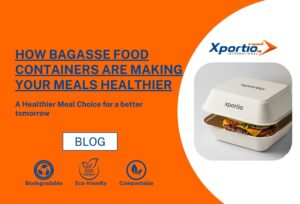Bagasse Packaging for Niche Sectors: How Airlines can make flights more sustainable
How Can Airlines Make An Upturn With Our Eco Friendly Travel Products
Air travel has long struggled with its environmental footprint, but a new era of sustainability is emerging—driven largely by innovative, eco-friendly travel products. Among the most promising solutions is bagasse: a byproduct of sugarcane, transformed into 100% compostable packaging. Unlike plastic and even aluminum containers, bagasse is fully biodegradable and breaks down without releasing toxins into the soil or food. Its compostability means that, rather than lingering for centuries, it vanishes harmlessly in around 90 days. Crucially, bagasse packaging contains no harmful chemicals—so it doesn’t leach microplastics or metals into meals even after weeks on the shelf. This makes it both planet-friendly and a far healthier choice for serving food onboard.
Table of Contents
1. Health First with Fly First
Passengers rightfully expect both safety and comfort from their airline meals. Traditional plastic containers, especially when used for hot dishes like biryani, can release microplastics into the food—posing long-term health risks. Recent studies show that humans unwittingly consume microplastics from such packaging, raising concerns over their effect on organ health and immunity. The solution? Adopting bagasse containers that are entirely plant-based, contain zero plastics, are PFAS free, and are safe for both hot and cold foods. Airlines that prioritize health can boost passenger trust and differentiate their brand by making the switch to these genuinely safe containers.
2. Serving Burgers & Sandwiches? Switch to Bagasse Clamshells
On short-haul and even long-haul routes, burgers and sandwiches are favorite in-flight meals. Typically, these come wrapped in plastic or foam clamshells that persist in landfills for decades. Bagasse PFAS free clamshells, on the other hand, are not only sturdy and heat-resistant but also truly biodegradable. After use, they begin to compost naturally—disappearing within just 90 days. Airlines can demonstrate environmental stewardship by choosing these anti leak food containers, signaling a commitment to eco friendly travel products that won’t harm future generations.
3. That Hot Coffee Served in a Paper Cup Contains Microplastics
The morning coffee ritual is a cherished part of flying for many passengers. Yet, what most travelers don’t realize is that conventional paper cups often contain a thin plastic lining to prevent leaks—leading to microplastic contamination, especially when hot drinks are poured in. By using bagasse cups paired with bagasse lids, airlines can eliminate this hidden health risk. These cups are leak-resistant, naturally insulating, and, importantly, do not deposit any harmful particles into beverages. Anti leak food containers made from bagasse provide passengers with the purest in-flight meal packaging, making every sip safer.
4. A Full Meal Served in Bagasse Mealtray is the Right Way
Many airlines still rely on plastic or aluminum trays, which contribute massively to onboard waste and landfill overflow. Switching to bagasse meal trays is a simple but powerful change: they are robust enough to hold a multi-course meal, withstand re-heating, and do not react with acidic or greasy foods. After their single use, they are quickly composted, closing the loop on airline waste. Airlines adopting this innovative in-flight meal packaging are aligning with global best practices for sustainability, while reducing the risk of chemical leachates in passenger food.
5. Airline’s Contribution to Generating Carbon Footprints
Though modern aircraft are becoming more fuel-efficient, the aviation sector is still a significant source of carbon emissions. While airlines work to innovate with fuels and aircraft design, they can address smaller but impactful details—like switching from traditional plastics to sustainable, eco friendly travel products in food service. Every bagasse tray or cup reduces the need for fossil-fuel-derived plastics and lessens landfill volume, directly helping airlines cut their carbon footprint. This step is both symbolic and practical in the fight against global warming and resonates strongly with eco-conscious travelers.
Conclusion
Bagasse-based anti-leak food containers represent more than just a trend—they are a concrete strategy for airlines to enhance passenger well-being, ensure food safety, and champion eco-friendly travel products. With in-flight meal packaging that is compostable, safe, and strong, airlines have an opportunity to make every flight a flight toward a greener future. Embracing these solutions isn’t just good for the planet, it’s good for business—and for every passenger looking to travel lightly on the world.

